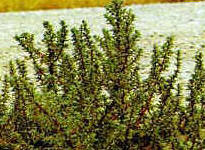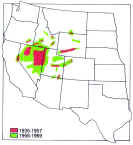|

Halogeton, a fast-growing annual plant of the Western States, frequently causes poisoning in sheep. Cattle may be also be poisoned. Livestock readily graze mature, dried halogeton and most losses occur when hungry animals are allowed to graze in heavy stands of halogeton. It grows from 0.1 to 1 m tall depending on the moisture available during the growing season. Each plant generally has five main stems that come directly from the base of the plant. Young plants have round, fleshy leaves that grow in little bunches along the stem. It has a characteristic small hair about one mm long on the end of each leaf. During drought the stems develop a reddish tinge.
The toxic substance in halogeton is sodium oxalate, which is contained in leaves and other above-ground parts. Halogeton is dangerous at all times. It becomes more toxic as the growing season advances, reaching a peak of toxicity at maturity. Losses occur from dried plant consumed during the fall, winter, and early spring.
Where and When It Grows
Halogeton often grows along railroad beds, roads, and sheep trails, and in places where the soil has been disturbed. Dense stands can be found on burned-over areas, overgrazed ranges, dry lakebeds, and abandoned dry farms. It thrives in the saline soils of colder semiarid regions- especially where native plant cover is thin. However, halogeton lacks the capacity to compete with vigorous perennial plants and the more aggressive annuals. Halogeton is a prolific seed producer. New plants established from February to mid-August produce a seed crop before the growing season ends in November. Wind, water, animals, and vehicles spread the seeds. Seeds may remain alive in soil 10 years or longer.
How It Affects Livestock
Total oxalate concentration varies from 3-30% of plant dry weight. The leaves have the highest concentrations and oxalate concentrations increase with maturity of the plant. Toxic oxalates chelate cations, especially calcium, forming insoluble salts that crystallize and damage vessels and renal tubular epithelium. Oxalates are also suspected of being metabolic inhibitors. The effect in poisoned animals is severe nephrosis with subsequent uremia and hypocalcemia. About 1 gm oxalate/kg bw is lethal in sheep. If fed at low doses for several days, the rumen bacteria become conditioned, resulting in increased tolerance (lethal doses are about 30% higher). Availability of other forages is also important as sheep can tolerate large amounts of halogeton if they eat it slowly with other forage at the same time. The first signs of halogeton poisoning occur 2 to 6 hours after an animal eats a fatal amount; death usually occurs in 9 to 11 hours.
Signs and Lesions of Poisoning
- Depression, weakness, and reluctance to move
- Respiration rapid and shallow
- Drooling
- Recumbency
- Coma
- Death between 2 hours and several days; death due to interference with energy
metabolism
- Hypocalcemia, uremia
- Renal tubular necrosis and crystals, hemorrhage, and hyperemia
How to Reduce Losses
Livestock losses may be reduced by maintaining range that supports good forage and by proper management of animals on halogeton-infested ranges. Supplemental feeding helps prevent halogeton poisoning when animals trail through or graze infested areas.
Do not introduce livestock into areas heavily infested with halogeton unless it can be done slowly to allow time for adaptation to the toxin. This can be accomplished by grazing plants such as shadscale or light stands of halogeton. Livestock should not be allowed to become hungry or thirsty while grazing in areas infested with halogeton. Death in livestock occurs when an animal eats a large amount of halogeton in a short period of time. Animals unloaded in halogeton-infested areas after train or truck shipment may benefit from supplemental feeding before grazing in the halogeton-infested areas. As most grounds around water tanks are infested with halogeton and many livestock graze indiscriminately after watering, livestock deaths often occurs after thirsty animals are watered.
Treatments for halogeton poisoning have not been definitely proven to be effective. It has been suggested that oral dicalcium phosphate may reduce oxalate bioavailability by forming insoluble calcium oxalates (3:1 salt to dicalcium phosphate or 5% calcium phosphate in alfalfa pellets). Treatment of hypocalcemia with intravenous calcium gluconate will correct the hypocalcemia, but does not reverse the clinical signs or course of the disease.
Because each plant produces vast numbers of seed, some of which may survive for 10 years or more in soil, it is not practical to eradicate any population that has been in existence for 2 years or more. Plants can be held in control by proper use of herbicides, and very small infestations can be eradicated if treated early. Research results indicate that several herbicides are effective for halogeton control. The low volatile ester of 2,4-D will kill about 97 to 98 percent of the plants when applied in late May or early June, but is not selective. Such treatments deplete other vegetation resulting in further invasion by halogeton (from seed in the soil) or other pioneer invaders, such as Russian thistle and rabbitbrush. Applications of 1 kg per acre of telbuthiuron as late as August will kill the halogeton and prevent reinvasion for 3 to 5 years. Apply 2,4-D with extreme care to protect broadleaf perennials. Use the herbicide only to treat small infestations of halogeton. Repeated treatments are necessary for control. Seeding infested areas with crested wheatgrass has been used extensively to crowd out halogeton and improve ranges.
Herbicide control of established stands on saline soils and low precipitation is not recommended. Follow recommended precautions when applying and handling herbicides.
|



